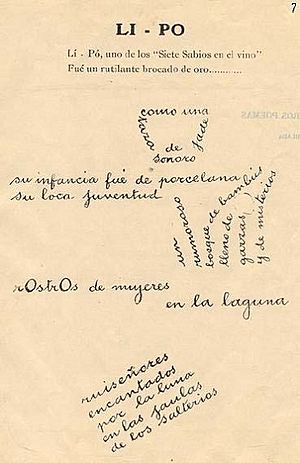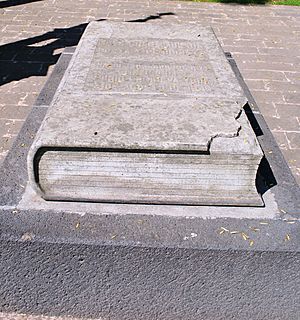José Juan Tablada facts for kids
Quick facts for kids
José Juan Tablada
|
|
|---|---|
 |
|
| Born | 3 April 1871 |
| Died | 2 August 1945 |
| Occupation | Diplomat, poet, critic |
José Juan Tablada (born April 3, 1871 – died August 2, 1945) was a famous Mexican writer and artist. He was a poet, someone who writes poems, an art critic, who judges and writes about art, and even a diplomat for a short time. He was one of the first people to study and share Asian cultures in Mexico. He also strongly supported Mexican art. Tablada spent a lot of his life living in other countries. As a poet, his style changed over time, from older ways of writing to new, experimental forms. He was very important for introducing haiku, a type of Japanese poem, to the Spanish language.
Tablada's Career and Travels
José Juan Tablada was born in Mexico City. He studied at Chapultepec Castle, a famous historical building. When he was young, he worked for the national railways.
In 1890, at just 19 years old, he started writing for magazines and newspapers. He wrote as a journalist, essayist (someone who writes short articles), and poet. In 1894, his poem "Onix" became very well-known because of its rhythm and detailed style. His first book of poems, Florilegio, came out in 1899. This book made him one of Mexico's first 'modernist' writers.

Early in his career, Tablada became very interested in Japanese art and culture. In 1900, he traveled to Japan for several months. This trip greatly influenced his writing and art studies. He later wrote a book about the Japanese artist Hiroshige in 1914. He also published En el país del sol (In the land of the sun) in 1919. This book was a collection of his articles about Japan, especially those from his 1900 visit. From his trip, he brought back a large collection of Japanese woodblock prints called ukiyo-e. These prints are now kept in the National Library of Mexico.
During a difficult time in Mexico called the Mexican Revolution, Tablada lived in Paris and then in New York City. In 1918, he became a cultural secretary for the Foreign Service. This meant he worked as a diplomat to share Mexican culture in other countries. He served in Bogotá, Caracas, and Quito. After leaving his diplomatic role, he spent much of his time in New York until 1935. There, he ran a bookshop and started a magazine called Mexican Art and Life. During this time, he was a strong supporter of Mexican art. He was one of the first to highlight the beauty of Pre-Columbian art, which is art made before Europeans arrived in the Americas. He also supported modern Mexican painters like José Clemente Orozco and Diego Rivera.
After returning to Mexico, he wrote part of his life story in a book called La feria de la vida (1937). In 1941, he was chosen to be a member of the Mexican Literary Academy. In 1945, he was appointed Vice-Consul for New York, but he passed away shortly after arriving there. His remains were later brought back to Mexico and buried in the Rotunda of Illustrious Persons in 1946. This is a special place where important Mexican people are buried.
Tablada's Poetry and Haiku
José Juan Tablada is known as one of the founders of modern Mexican poetry. He is also famous for bringing haiku to Mexico. Haiku is a short form of poetry that comes from Japan. It usually has three lines with a 5, 7, 5 syllable pattern.
His book Un dia (1919) has 38 short poems. It is considered the first book of original haiku written by a poet outside Japan. After that, he published Li-Po y otros poemas (1920), which included calligrams. Calligrams are poems where the words are arranged to form a picture. In 1922, he released El jarro de flores, which had 68 more haiku.
Tablada's haiku are known for their beautiful style and sometimes for their humor. Here are some examples:
- Slight willow,
almost gold, almost amber, almost light….
- Moonlit roofs beyond the window,
Chinese shadows inky black and the Chinese music of cats.
In 1921, his friend, the composer Edgard Varèse, used one of Tablada's earlier poems, La Cruz del Sur, in his music piece Offrandes. Two years later, Varèse dedicated another piece, Hyperprism, to Tablada. After Tablada's death, the composer Luis Sandi set ten of his haiku to music for voice and piano in 1947.
See also
 In Spanish: José Juan Tablada para niños
In Spanish: José Juan Tablada para niños


